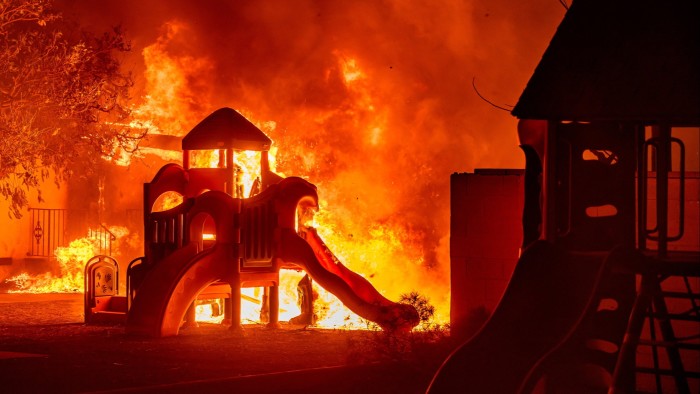Stay informed with free updates
Simply sign up to the US & Canadian companies myFT Digest — delivered directly to your inbox.
California is a tinderbox filled with giant, valuable houses. This creates problems not only for property insurers, but also for the state’s investor-owned electricity providers.
When it comes to Los Angeles’ devastating wildfires, one big question is whether publicly traded utility Edison International (ie Southern California Edison) will need to pay as much as $3.9bn to reimburse a state fund created to help cover the cost of highly destructive fires.
In California, investor-owned utilities like Edison can be held liable for wildfires caused by their equipment. Years ago, this caused many dire warnings that its electrical utilities could be “uninvestable”, despite the fact it was mostly a legal consequence of utilities’ ability to seize land through eminent domain.
Utilities’ potential wildfire liabilities have since then been capped by a state law called AB1054. This legislation was the response to a horrible 2019 wildfire season that led Northern California utility PG&E to file for bankruptcy. PG&E also plead guilty to 84 felony counts of manslaughter, but this had relatively few financial consequences, as it emerged from bankruptcy with more debt than it had before and funded half of its settlement payments to wildfire victims with shares, not cash. (Insurers, in contrast, got all cash, and have returned the favour by withdrawing en masse.)
The linchpin of this law was a wildfire fund, with a targeted size of $18bn to $21bn, to help cover wildfire claims that property insurers ask utilities to cover through a process called “subrogation”. That fund was partly, but not entirely, funded by the utilities’ investors.
If Edison’s equipment caused the fires in Southern California, the fund will probably absorb some of the utility’s costs (depending on what fires the state determines is “covered”). And if Edison was found to be negligent, it will be required to reimburse some of those fund costs, up to 20 per cent of its equity rate base.
Edison’s maximum reimbursement would be around $3.9bn, according to CreditSights analysts Andy DeVries and Nick Moglia.
At first glance, that sounds tame compared to the estimates of insured losses from the fires. Morningstar DBRS estimated yesterday that they could be “in excess of $8bn”, JPMorgan’s analysts estimate insured losses of up to $20bn, and Barclays has floated up to $30bn.
The problem is bigger than Edison’s potential payments, however.
Any fires that draw down California’s fund raises the risk that the state will have to find a new way to fund wildfire risk. Or to put it more accurately: It speeds up the timeline over which utilities will lose a state subsidy funded by California ratepayers, meant to help them cover insurers’ subrogated claims for wildfire damage.
That means if Edison’s equipment started the fire, it could affect all electrical utilities operating in wildfire-prone areas, and especially PG&E, the CreditSights analysts argue.
DeVries says that if the wildfire fund is drawn down by 25 per cent or more, that could affect rating agencies’ views of California’s publicly traded power companies, because they’ll no longer have a government-subsidised method of wildfire loss mitigation. Edison’s bond yields (and borrowing costs) have increased since fires started. Depending on whether Edison was responsible for the fires, that means PG&E’s could, too.
The bright side — if only for the state’s investor-owned utilities — is that the law that created the wildfire fund also raised the burden for showing a utility was negligent. That change will persist whether or not the wildfire fund is around.
https://www.ft.com/content/d0c58ae7-d505-48cb-a496-18ee36ad5219


